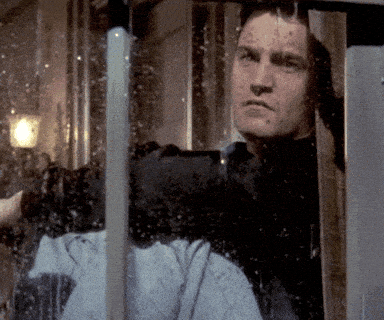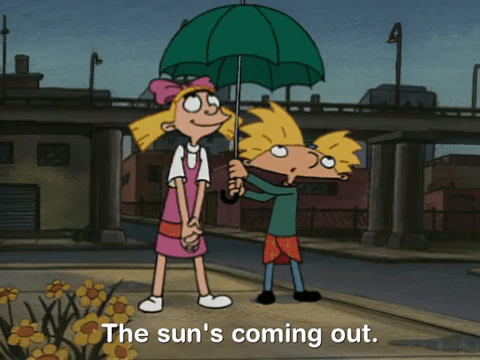- The Scarlet Letter
- Posts
- April Showers, Coming In Hot
April Showers, Coming In Hot
April Showers, Freedom Scones, Old Floods

Are you interested in sponsoring the best local newsletter on the planet? Reply to this email to help your organization reach hundreds of thousands of engaged Columbusites.
Top of Mind
High Water, Low Patience: Columbus Gets Drenched (and Then Some)
April showers? Try torrential downpours, tornadoes, and 70 road closures. Welcome to spring in central Ohio, where the only thing more unpredictable than the weather is which roads will be underwater next.
The Great Soak
Over the past week, Columbus turned into the Midwest’s least-desired water park. Between Wednesday and Sunday, we got about 3.5 inches of rain, and that’s just in Columbus proper. Upper Arlington clocked over 4 inches, Galena nearly five. If you’ve recently discovered a basement swimming pool, congrats. You’re not alone.
The Franklinton floodwall was activated Saturday like a waterproof Bat-Signal, and the city scrambled to install floodgates on Greenlawn and Harmon Avenues to keep the Scioto River at bay. Spoiler alert: it didn’t entirely work. The river crested at 22.39 feet near Frank Road, which is well into “maybe don’t drive through that” territory.

Photo from the Columbus Dispatch
Twisters? Sure, Why Not.
Because biblical rain wasn’t enough, the weather gods threw in some tornadoes for variety. Six of them, actually, including an EF1 in Fayette County that crossed I-71 and tossed around trees like it was spring cleaning. The week before, we had four more twisters in southwest Ohio. That’s ten tornadoes in two weeks, which feels excessive unless you’re auditioning for a reboot of Twister.
Columbus, Underwater Edition
City utilities took over 200 calls from residents with flooded basements, clogged drains, and general "why is my street a river?" vibes. East of the Olentangy and north of 670 seemed to take the brunt, but really, everyone got a taste.
AEP reported around 20,000 outages during the peak of the storms, proving once again that spring in Ohio is powered by wind, water, and mild panic.

Photo from the Columbus Dispatch
The Road Ahead (If It’s Not Closed)
The rain's slowing down (finally), but the forecast still has some snow and sleet lurking, because Mother Nature is on her chaos arc. The Scioto should drop below flood stage by Tuesday, but maybe don’t store anything valuable on your basement floor just yet.
Moral of the Story?
Build an ark, download a weather app, and maybe don’t plant those Bradford pears. This is Ohio, where the seasons change in a day, and the rivers rise faster than your tolerance for weather-related group texts.
Stay dry. Stay safe. And maybe invest in some waterproof shoes.

Scarlet Letter Trivia
Question: July 13th, 1992 was the wettest day in Columbus’s History. How much rain fell of this historic day.
A) 5.13 inches
B) 4.8 inches
C) 8 inches
D) 6.69 inches
Not Just a Café: The Healing Power of French Toast and Fresh Starts
Walk into Freedom a la Cart, and it feels like any great neighborhood café. The coffee’s hot. The quiche is perfect. There’s a quiet hum of conversation, the smell of cinnamon and sourdough in the air. But behind the counter, past the pastries and pretty lattes, something extraordinary is happening.
This isn't just a café. It's a catalyst.
Freedom a la Cart exists for a purpose bigger than brunch. It’s a Columbus-based social enterprise that serves incredible food while helping survivors of sex trafficking reclaim their lives. For many, it’s the first workplace where they’re seen, supported, and believed in.
Each meal, each order, each shift is part of a larger mission: to break cycles of exploitation and build pathways to freedom. And they’re doing it, one sandwich, one skill, one second chance at a time.
Where Hope Is on the Menu
There’s something poetic about serving hope with every coffee. And if you ask the folks behind Freedom a la Cart, they’ll tell you that even small wins, like mastering a recipe or answering the phone, can be the beginning of something massive.
Their downtown café is open to the public, and yes, the food is fantastic. But the real magic is knowing your morning scone helped someone on their path to independence. That your lunch meeting helped fund job training. Your support creates a ripple effect far beyond the bakery case.
This year, they’ll walk alongside around 400 survivors. They’ll celebrate progress, weather setbacks, and continue proving that healing happens not just in courtrooms or clinics, but in kitchens, too.
How You Can Help
Grab a coffee. Tip generously. Host your next meeting there. Tell your friends. And if you want to do more, donate or volunteer. Because real change is built locally, intentionally, and often starts with a plate of eggs and a place to belong.
At Freedom a la Cart, lives aren’t just changed, they’re rewritten. With care. With the community. And with a side of cinnamon rolls.
The Flood That Changed Everything: Franklinton, 1913
Before it was the up-and-coming arts district with breweries and bike trails, Franklinton was just “the Bottoms,” a low-lying, working-class neighborhood that sat a little too comfortably next to the Scioto River. And in March 1913, the river reminded everyone exactly who was in charge.
A Perfect Storm (Literally)
Over Easter weekend in 1913, the skies opened up with relentless rain. In just five days, Columbus saw nearly seven inches of rain, more than the entire month’s average. The ground was already saturated, the rivers were full, and the city’s drainage systems were woefully unprepared for what came next.
On March 25, the levee protecting Franklinton failed, and the Scioto River surged into the neighborhood like it was reclaiming lost territory. Within hours, homes were underwater. Streets became canals. Entire blocks vanished beneath six to fifteen feet of water.
Devastation on a Historic Scale
More than 90 people in Columbus died, many of them in Franklinton. Over 500 homes were destroyed. Thousands were left homeless. And the flood didn’t just take buildings it wiped out businesses, churches, and schools. At one point, boats were the only way to reach the neighborhood. A temporary morgue was set up downtown. The National Guard was called in.
It wasn’t just the worst flood in Columbus’ history, it was one of the worst natural disasters in Ohio's history, part of a regional catastrophe that devastated cities from Dayton to Cincinnati.
How the Flood Changed the City
The 1913 flood finally forced Columbus to take flood control seriously. Levees were rebuilt. The city constructed a massive floodwall system along the Scioto, an effort that would take decades to fully realize. Franklinton itself never quite recovered. Once seen as a promising hub, it was labeled a floodplain, and development stalled for generations.
Insurance rates soared, investment dried up, and for decades, the neighborhood struggled under the weight of that watery past.

The rest of the pictures are sad, so here’s a fun one
A Legacy That Still Lingers
Even today, the memory of 1913 lingers in Franklinton’s DNA. When the floodwall was activated this past weekend, some longtime residents knew exactly what it meant. The fear of rising water is generational. And while the 1913 disaster feels like ancient history to most, it’s the reason the neighborhood is shaped the way it is geographically, economically, and emotionally.
So next time you're walking past a sleek gallery or ordering a pour-over on West Broad, remember: Franklinton isn’t just a trendy zip code. It’s a survivor. Built, flooded, and rebuilt again.
And if you think this city doesn’t have grit, you haven’t read the waterline.
Trivia Answer:
A) 5.13 Inches in one day! that’s so much rain, geez.

Arrivederci







